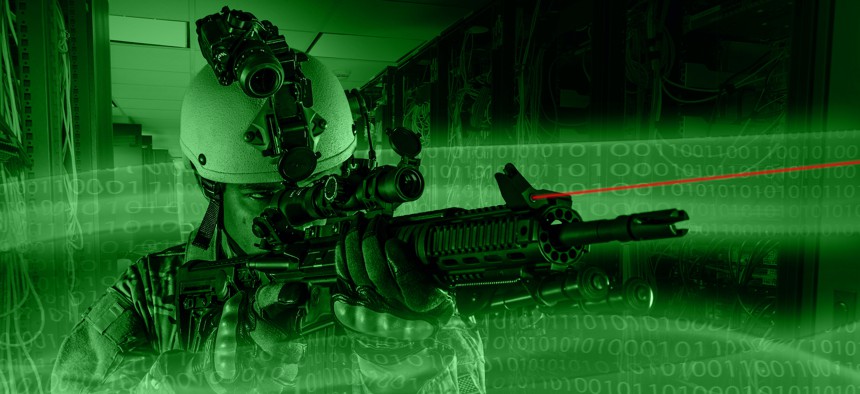
Getty Images / Jon Feingersh Photography Inc.
Data Friendliness Will Make Some Weapons More Valuable, Says Northrop CTO
Future weapons will have more value if they connect more easily to the network right out of the box, but that’s not the way military weapons or networks are made today.
Just as consumers like headphones and other audio gear that seamlessly connects to their streaming data, future militaries will be more interested in weapons that quickly and intuitively connect to larger networks—more so even than high-performing weapons that don’t share data well, Northrop Grumman CTO Scott Stapp said Monday.
The defense industry—and particularly, traditional prime contractors—are grappling with the military’s new insistence that they more freely share data: among weapons, over the new battle nets, to uniformed maintenance personnel, with Defense acquisition officials, and more. It’s the sort of change that will disrupt the way the contractors do business. Stapp said defense contractors will eventually stop fretting about opening their data silos and instead offer new software tools to combine and then use that data.
“I think it opens a new model for the defense industry, which, in a lot of ways, looks a lot like commercial when it comes to data,” he said in an interview. He likened it to Apple, which went from a company that sold computer hardware to a company that sold hardware that seamlessly interlinked to cloud-based data services across devices.
The other side of that, Stapp said, is that new weapons, vehicles, or physical tools that easily integrate into broader network structures will become more valuable than those that don’t.
“You're gonna see the new competitive ecosystem emerge—we're forecasting—between different manufacturing entities in terms of how easily what they're making is absorbed into the larger... network structure,” he said.
That’s going to open up opportunities to use some weapons in new ways, like large stealth bombers as intelligence or airborne early warning platforms. After dropping its weapons, a stealth bomber “may have another six hours or so of stand-in” flying, he said. “What he may decide to do is say ‘I’m going to be a stand-in battle manager. I’m going to help guide in long-range fires to different things because I’m getting all this data.’ So you utilize them as a battle manager.”
Scott made his remarks on the sidelines of the Navy League’s Sea Air Space conference, where the Navy also addressed its efforts to link more platforms together.
Kelly McCool, the acting director of the Navy’s Digital Warfare Office, said the Navy’s current efforts are several steps below converting bombers into new types of aircraft based on need.
In the near term, McCool said, the Navy aims to move beyond rigid data and communication architectures that prevent sharing. “There’s a recognition that in the future we won’t be so dependent on specific formats, like the rigid formats we have” with the Link 16 tactical data standard. Last year, she said, the Navy sought to understand how those rigid data standards were slowing down operations and how more sharable data would change the way the Navy finds and hits targets.
“We tried to define ‘What is the data that we need to maximize our weapon opportunities when we’re looking at surface targets?’ Typically, with Link 16 we use a J3.3 message. It’s not the best message,” she said on a panel about Joint All-Domain Command and Control.
McCool said the Navy has since defined a new standard for transmitting data about ships and other craft in a given space. “We’re getting that codified now… So that can get out into contracts.”
Ultimately, she wants to better apply machine learning or artificial intelligence to data “I would love to see us get to data tagging that allows it to be much more machine driven and get it out of the nebulous policy and into really defining what data is releasable at the element level and moving that forward. That’s a tall ask,” she said.




